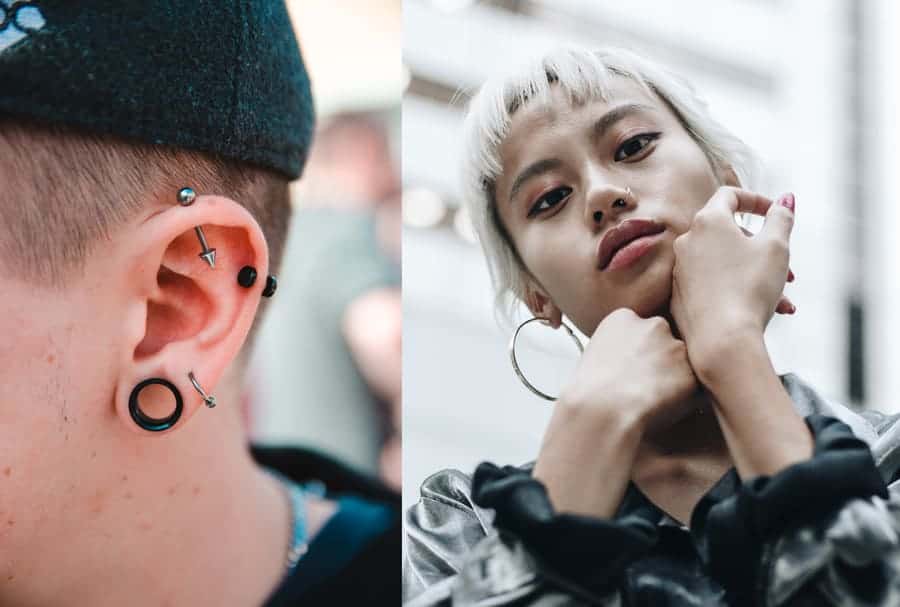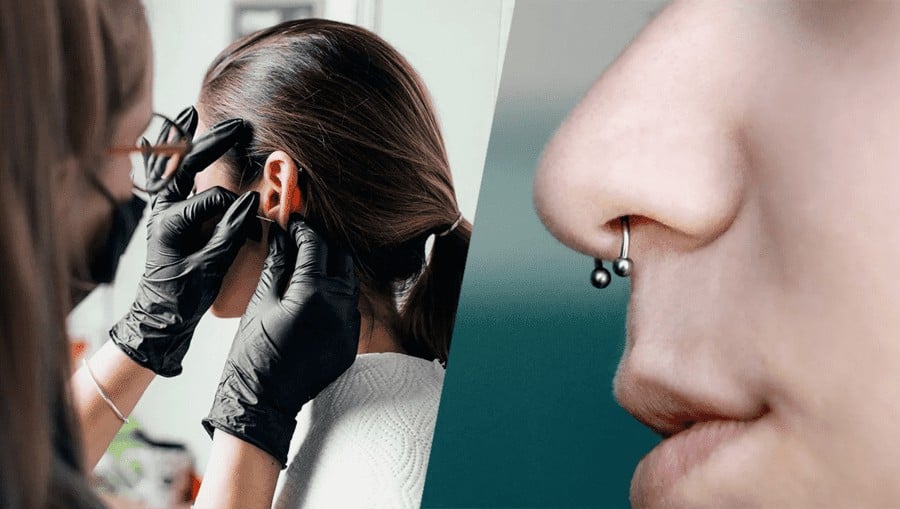Hello everyone, this article is to educate the community of tattoo & piercing lovers alike on the dangers of using sterling silver or cheap body jewelry for fresh piercings, and why you need to beware of these cheap tattoos and piercing shops. By the end of this article, you will know how to guard yourself against cheap Piercing shops.
There are two types of tattoo and piercing parlors in the world. High-Quality and Low-Quality Studios!
Let me explain the difference between the two while giving you a few red flags to look out for.
The High-quality tattoo and piercing studios use brand-name jewelry and equipment that is truly best for you and your health regarding body modifications. The procedure will be done correctly with no problems or issues! The artist takes their time with you ensuring you know how to clean the area or take care of the piercing so there are no keloids, piercing bumps, or worse, an infection that can occur if it’s not taken care of properly!
Before you leave the studio, the piercing artist will verbally explain your aftercare instructions, and then provide you with an aftercare sheet via email or paper. The aftercare sheet offers step-by-step instructions and or video links for adequately caring for your new piercing or tattoo. After reviewing the content, you should be on the correct path to healing with no wondering questions.
Then we have these Low-quality studios. Unfortunately, there are more of these shops in town than High-quality studios, trust me! That’s why we’re making this article for you, so you don’t make the same mistake as others and end up with a disaster piercing from an untrained piercer.
These shops are easy to spot because they usually do those:
“20$ PIERCING” or Tap out piercing sessions.
These shops are unhygienic and use cheap sterling silver as a default for all their piercings. They don’t follow proper procedures, use cheap disposable clamps, and use body jewelry filled with nickel and other contaminants bought from China in bulk. These shops usually put the wrong type of jewelry in piercings that were just performed, and the list goes on. But If you see the “Infamous piercing gun”! Just walk away fast and look up your local nickel-free piercing studio for help.
Piercing cartilage with a gun can create hardcore hypertrophic scarring and even blow it up. Some people have a stigma about needles, but they’re less painful because they’re designed to pierce the skin, whereas the piercing gun just delivers a blunt force to push an earring through.
Professional body Piercers will not do any of these things.
Low-quality studios are quick to take your money, and they will usually pierce you crooked because they need to use tools to measure appropriately. Instead, they do it without tools and use cheap jewelry that irritates your skin. On most occasions with these low-end piercing studios, They will get an untrained piercing apprentice to perform the procedure without telling you, While still charging you the full price.
The apprentice piercer is still learning how to do piercings, and the shops don’t give discounts or refunds for the mess-ups or for the inconvenience of being a genie pig, so watch out for places like this.
Those reasons are just a few Red flags that they are a terrible piercing studio.
A high-quality studio knows what piercings are suitable for your long-term health, And understands what metals are best for you and your body piercing. In addition, the piercer will comprehensively know how to take care of your new body modification and explain it thoroughly, no matter the piercing, while providing you with all the information you will need to care for your new body modification and investment.
This is where the professional tattoo & piercing studios are paving the way for our community and customers. We only practice Association of Professional Piercers piercing procedures to ensure our clients have the safest environment. to be pierced in. Therefore, we only use premier surgical stainless steel as a default for all our procedures. The grade is 316(L) surgical stainless steel.
The (L) means there’s low carbon in the metal.
However, every respectful nickel-free piercing studio, should only provide high-quality jewelry, and you can always be able to upgrade your metal to a more pure metal like titanium or niobium.
This kind of studio should focus on bringing the highest-quality metals available on the market and carry a wide variety of high-quality jewelry in-store, including both internally and externally threaded jewelry so that it can appease all your body jewelry needs. As a reseller of neo-metal and anatometal body jewelry, it should also have luxury jewelry.
So Knowing the difference between what metals are safe for your body piercing will save you a lot of problems later, and you will save yourself a nasty scar.
Harmful metals are unhygienic, affect your body’s healing time, drastically increase your risk of infections, and cause a reaction to your skin around the piercing that turns your skin green. You may even develop a piercing bump caused by cheap body jewelry.
The most common irritation culprit is nickel, a metal used in many inexpensive or mixed metals like sterling silver. These are what is used for those “20$ piercing” specials and tap-out piercing sessions you might have seen or heard about. But the reality is most people today have a sensitivity to even minuscule amounts of nickel when they get a new piercing. So if your skin turns green or black (or becomes stained) when you wear costume jewelry, sterling silver or even some types of gold may be reacting to the nickel or another ingredient in the metal mixture used to create that piece of cheap body jewelry.
Now that I’ve given you a few red flags for low-quality piercing studios let me explain the different types of jewelry that a quality studio should offer to its clients, and then I’ll recommend the ones we avoid as professionals.
Surgical Stainless Steel (SSS)
Surgical stainless steel (SSS) is very commonly used for body piercings because it is both hypoallergenic and affordable for us to use. There are several grades and varieties of surgical stainless steel on the market, but for safe and effective body piercings, we seek out the following types:
- 316L (the “L” refers to “low carbon”) This is the most commonly utilized surgical stainless steel for body jewelry. It is durable in body implants and doesn’t typically react with body fluids.
- 316LVM (“VM” indicates that the metal is produced in a vacuum) is similar to 316L but has a smoother finish.
Clients that have very sensitive skin should consider that (SSS) contains small trace amounts of nickel, so it’s worth checking in with your dermatologist to find out if SSS could irritate your skin before selecting this metal for a piercing. We recommend upgrading your jewelry to titanium or higher for the best healing overall.
Titanium
While it can be tempting to go for a lower-cost piece of jewelry like (SSS) for a new piercing, Many professional piercers and experts agree that investing in High-quality materials will result in a safer experience with a cleaner healing process. For that reason alone, Reef Side Tattoo & Piercing recommends “implant-grade” titanium, which is super durable and contains just tiny amounts of nickel.
When [titanium] comes from a reputable company, it has a high polish and is hypoallergenic, making healing you’re new piercing a cakewalk. In addition, titanium handles moisture well and is very safe for the long-term wearing of your body piercings.
Titanium is a top choice for piercings because it’s biocompatible, meaning your body accepts it. In addition, titanium is so safe that it is used as the metal of choice for surgical implants for body modifications.
Niobium
If you’re looking for a beautiful piece of High-quality jewelry, then this hypoallergenic metal is for you. This metal falls between SSS and titanium in terms of price and quality. Like titanium, niobium is biocompatible, providing plenty of shine, bling, and impressive structural integrity. Also, niobium comes in a massive range of colors, making it an easy match for anyone hoping to customize their look and style.
14K/18K Gold
When it comes to gold body jewelry, it’s essential to pay attention to the quality and composition of the gold jewelry itself. Many studios carry jewelry that calls itself “gold” but consists of gold-plated metals, and gold plating can easily rub off and expose the underlying metal, causing irritation or, worse, infection.
You might think pure gold jewelry is safe for piercings, but that’s not 100% true. For example, body jewelry made from 24-karat gold has a very soft surface, which traps bacteria and nicks easily, leaving marks on your jewelry. But solid 14K and 18K gold jewelry works great for piercings. Unlike lower-end gold-plated options, these materials won’t degrade over time as efficiently. In addition, it has a tolerance to moisture, sweat, and extended water use so it won’t cause irritation.
Platinum
Platinum is excellent for its shine, lack of reactivity, and rarity, but it holds a vaunted position among high-value metals. Platinum is safe for first piercings [because] it’s inert and hypoallergenic. So it’s good [as an alternative] when people have skin allergies to silver or gold.
But, there is one drawback to platinum piercings. It’s expensive! Platinum can be a worthwhile investment for clients seeking an excellent yet hypoallergenic piece of body jewelry, but you’ll have to ensure that your budget can afford it.
Now that I’ve briefly explained the differences between the metals used in high-quality body jewelry, let’s go over the worst option available for piercings, cheap sterling silver.
Silver & sterling silver Body jewelry (NOT RECOMMENDED)
Sterling silver is made up of 92.5 percent silver and contains other metals that will irritate your skin. It also oxidizes or tarnishes when it comes in contact with air and body fluids. In addition, the metal is soft and is, therefore, prone to tiny nicks and scratches that can harbor bacterial growth. Sterling silver is OK for fully healed earlobe piercings and short-term wear. But it’s not OK for all piercings, so avoid Sterling silver and any silver-plated jewelry.
This is why the LOW-END piercing studios use it for their $20 piercing specials. They buy this metal in bulk, and it often markets itself as “hypoallergenic”. But this is false because it sold for healed piercings. Still, sterling silver is typically made from 92.5% silver and 7.5% other metal, usually copper or nickel. While copper makes the silver more durable, it will also be more likely to react with your body’s fluids.
Some clients who like the look of sterling silver’s shine but want to stay away from copper instead opt for pure silver (or “fine silver”) like Clairs offers, which claims 99.9% silver content. Pure silver is considered hypoallergenic, but we urge clients to approach silver jewelry cautiously if they go to another studio. The main reason I’m telling you this is pure silver, like high-karat gold, is exceptionally soft, leaving it vulnerable to scratching, chipping, and other infection-promoting types of wear and tear.
So don’t be a sucker and fall for that cheap $20 piercing special or tap out piercings sessions. Instead, choose quality and experience the difference that professional tattoo & piercing shops offer you.

